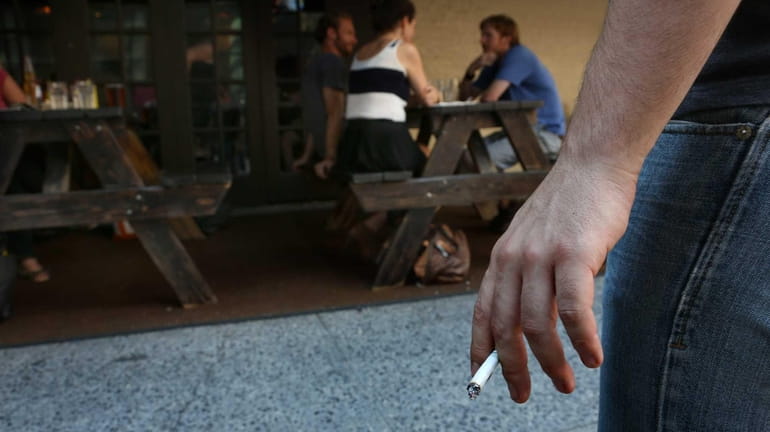City ban has made real inroads against smoking

A customer stands away from a Manhattan restaurant to smoke a cigarette. The city says fewer restaurants then ever before are breaking the rules since the indoor smoking ban went into effect eight years ago. (July 6, 2012) Credit: Craig Ruttle
New York City's ban on smoking in bars and restaurants was controversial at first, but a decade after its adoption, it's widely accepted.
And it's probably helping. The ban was part of a broad attack on smoking in the city, so it's hard to say which measures deserve the most credit. But a city Health Department survey in 2010 found that the proportion of New Yorkers who smoke had fallen to 14 percent from 22 percent in 2002.
More recently, data for the first half of this year show that tickets for non-compliance issued to city bar and restaurant owners are on pace to come in 83 percent below the number issued in 2003, when the law took effect, even though the number of inspectors has nearly doubled.
While the citation numbers bounce around (they were even lower in 2005), there is little doubt that most New York taverns and eateries are complying. Last week the head of an industry trade group, whose members initially complained about the ban, said everyone's grown used to the idea that you can't smoke indoors, at least when you're not home.
Overall, 36 states including New York have adopted some kind of ban on smoking in bars and/or eateries. And counting local laws, 81 percent of Americans live in places covered by them, the American Nonsmokers' Rights Foundation says. Suffolk County recently followed the city in banning smoking in parks and on beaches. Now there are smoking bans all over the place. Nassau County bans smoking in almost any public indoor space. Rockland County bans it in cars with children aboard.
America has some frustrating public health problems, but we're world-beaters when it comes to kicking the cigarette habit. Yet we still have a long way to go on this front; 1 in 5 deaths in this country is a result of smoking, which the government estimates kills 443,000 Americans annually.
While prohibition isn't usually effective in combating unhealthy products, it's clear tobacco use can be reduced by limiting where people can smoke, raising the price through taxes, and tarring the habit with social disapproval. Efforts like the ones in New York, which was the first major city to adopt the bar and restaurant ban, surely help.
